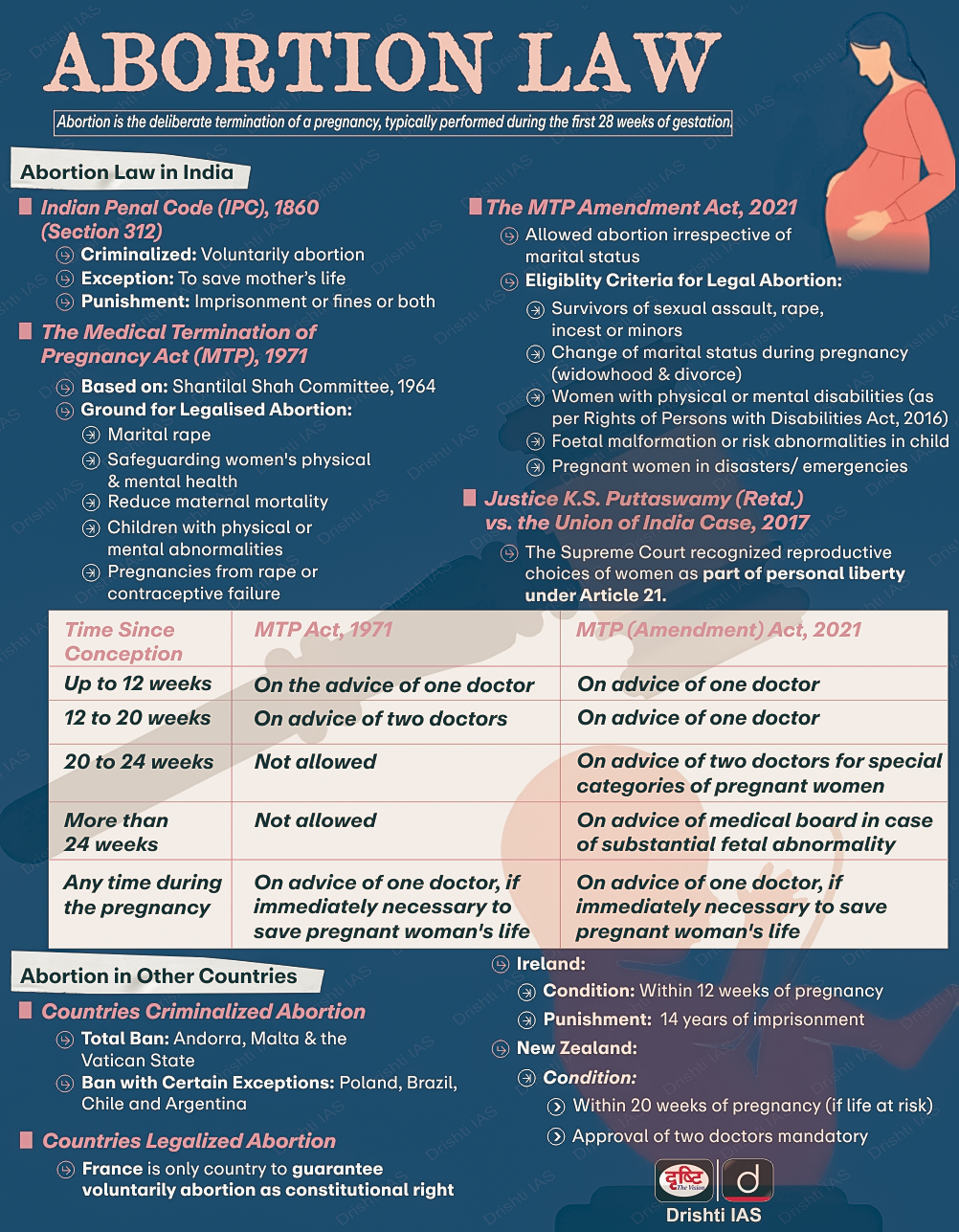Social Justice
Barriers to Abortion Access in India
- 29 Mar 2025
- 6 min read
For Prelims: Supreme Court, Bharatiya Nyaya Sanhita, Article 21, Medical Termination of Pregnancy Act, 1971
For Mains: Abortion Laws in India, Women's Autonomy and Reproductive Rights in India
Why in News?
The Supreme Court's (SC) denial of late-term abortions in borderline foetal viability cases (24–30 weeks), has reignited the debate over reproductive rights in India..
- Despite legal reforms, ethical dilemmas, procedural delays continue to obstruct timely access to abortions.
What is Abortion?Click here to Read: Abortion |
What is the Legal Framework for Abortion in India?
- Pre-1971 Legal Position: Under the Indian Penal Code (IPC) Sections 312 and 313, abortion was a criminal offence.
- Shantilal Shah Committee: In response to increasing unsafe abortions and maternal mortality, it recommended a broadening and rationalisation of laws related to abortion in 1966 to protect women’s health.
- MTP Act, 2021: The Medical Termination of Pregnancy (MTP) Act, 1971, last amended in 2021, allows abortion up to 20 weeks with the approval of one registered medical practitioner (RMP).
- Between 20 and 24 weeks with the approval of two RMPs.
- Beyond 24 weeks, a state medical board determines abortion eligibility based on specific conditions, such as foetal abnormalities incompatible with life or a serious risk to the mother's physical or mental health.
- Bharatiya Nyaya Sanhita: The Bharatiya Nyaya Sanhita (BNS) (formerly the IPC) continues to criminalize abortion outside these legal exceptions of MTP Act, 2021.
- Judicial Interventions: Justice K.S. Puttaswamy v. Union of India, 2017 affirmed that abortion is part of a woman’s right to privacy and liberty under Article 21.
- The SC ruled that unmarried women with pregnancies between 20 and 24 weeks are entitled to the same abortion rights as married women, affirming that reproductive autonomy, dignity, and privacy grant all women equal rights to choose whether to continue a pregnancy.
What are the Barriers to Abortion Access?
- State Mandated Polices: Mandatory pregnancy registration in states like Haryana risks violating Section 5A of the MTP Act (which ensures strict confidentiality for women undergoing abortions) compromising women’s confidentiality, increasing stigma, and potentially pushing them toward unsafe abortions.
- Lack of Abortion-on-Demand: Abortion in India is conditional, unlike in jurisdictions (like US) where reproductive autonomy is paramount.
- Foetal viability: Foetal viability is medically and ethically uncertain, generally assumed at 24 weeks but dependent on medical infrastructure and gestational health.
- Advances in neonatal care may further reduce this threshold, impacting abortion laws.
- Courts weigh foetal rights against a woman's autonomy, especially in borderline viability cases (24–30 weeks), often overlooking mental or emotional well-being.
- Medical Board Delays: Decisions are made on a case-by-case basis, often leading to delays that push pregnancies even further.
- Boards lack standardised protocols and may apply subjective ethical considerations (perceptions of foetal life) over clinical evidence.
- Specialist Shortage: Abortion laws require gynecologists or obstetricians, but rural areas face a 70% shortage, per 2019–20 Rural Health Statistics and lacks neonatal intensive care units (NICUs).
- Legal Fear: Since abortion is an exception rather than a guaranteed right, healthcare providers fear legal liability, especially in complex cases.
- Hospitals sometimes require unmarried women to report to the police, leading to potential legal complications.
- Stigma: Women seeking late-term abortions are often met with judgmental attitudes, and intrusive questions. Unmarried women, minors, or widowed face even greater scrutiny.
What Can Be Done to Improve Access to Abortion Care?
- Abortion as a Healthcare Right: Shift from a permission-based approach to a rights-based framework, recognizing abortion as essential healthcare within legal gestational limits.
- Enhance Privacy Protections: Avoid mandatory pregnancy registration; reinforce confidentiality as per Section 5A of the MTP Act.
- Medical Abortion (MTP) Pills: Ensure availability of MTP pills across pharmacies and health centres with regulatory oversight.
- Expand Provider Base: Train general physicians and mid-level providers for early-stage MTPs. Strengthen rural healthcare infrastructure to ensure safe and timely access.
- Improve Sex Education: Enhance sex education with accurate, stigma-free information on contraception, and abortion to prevent unwanted pregnancies and unsafe procedures.
|
Drishti Mains Question: What are the barriers to Abortion Access in India across different socio-economic contexts, and what can be done to ensure reproductive justice? |
UPSC Civil Services Examination, Previous Year Question:
Mains
Q. What are the continued challenges for Women in India against time and space? (2019)





